At Montclair State Google “Solve for X” Preliminary, Innovators Pitch “Moonshots”
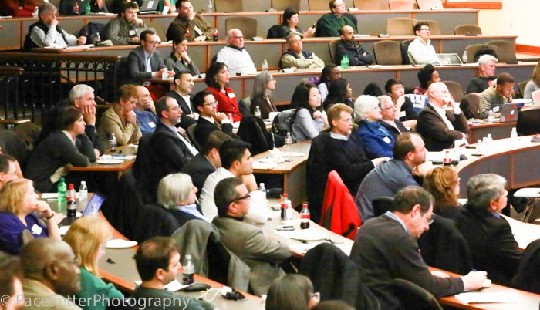
At the first preliminary Google Solve for X event, five innovators with huge world-changing ideas described their “moonshots” — radical solutions to problems affecting millions or billions of people — to several hundred attendees who packed an auditorium at Montclair State University on Dec. 11.
These five innovators presented standout pitches, with ideas that can’t be ignored. As one person commented, “It’s amazing to know there are so many big thinkers in this area. The presentations were inspiring.”
The Solve for X event was organized by GDG North Jersey, a group headed by Todd Nakamura, but it had help from a large staff of volunteers. GDG North Jersey was one of only 12 groups worldwide, two of them in the U.S., to be selected to find big, audacious ideas and bring them to Google’s attention.
Two more local Solve for X preliminary events were scheduled. One took place in New York on Jan. 7 and the other is coming up at the Stevens Institute of Technology on Jan. 15. GDG North Jersey is also traveling to the Boston area to hear “moonshots” there. The main, final event will be held at Rutgers University on Feb 2.
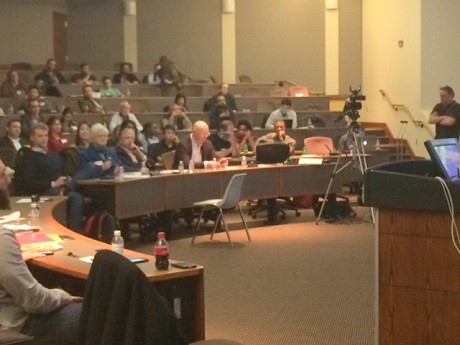
In Montclair, panelists who listened to the presentations, and asked questions of the presenters, included John Frankel, founding partner of ff Venture Capital; Dennis Bone, formerly president and CEO of Verizon New Jersey, and now founding director of the Feliciano Center for Entrepreneurship, at Montclair State; Susan Okin Goldsmith, a partner at McCarter & English and a specialist in patents and trademarks; and Troy Hollar, COO of Merlin Organics.
The crowd was eager to hear what the presenters had to say.
Food Waste Recycling Moonshot
First up was Olive Lynch, president of Green Waste Technologies (Plainfield), whose “moonshot” was a food-waste recycling method that can also boost food production. Food waste is the last bastion of recycling, said Lynch, and it’s a big problem. In developed countries, food waste occurs mainly on the consumer side. About 50 percent of the food waste ending up in landfills comes from restaurants, she told the group.
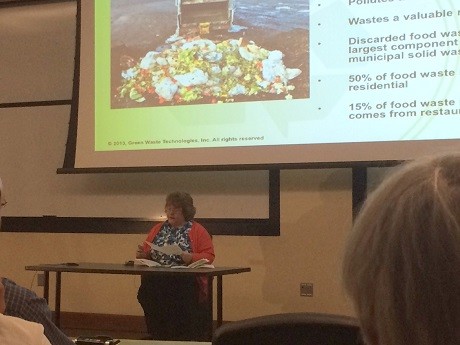
| Esther Surden
“The other major problem we are solving is food production, especially protein. Fish are important to this, and the problem is that we are fishing our oceans to extinction,” she said. Lynch proposes using a special species of fly, the black soldier fly, that only lives for five days and doesn’t have a mouth. The larvae grow tremendously large, and are eating machines. She proposes increasing fish production by feeding larvae to fish after the larvae themselves have fed on food waste.
A video of her presentation can be found here.
Gravitational Theory of Quantum Mechanics Moonshot
Presenting next was Mark Annett, a patent agent and CEO of Annett Enterprises (Livingston), a product-development think tank. He wowed the audience with his “gravitational theory of quantum mechanics.”
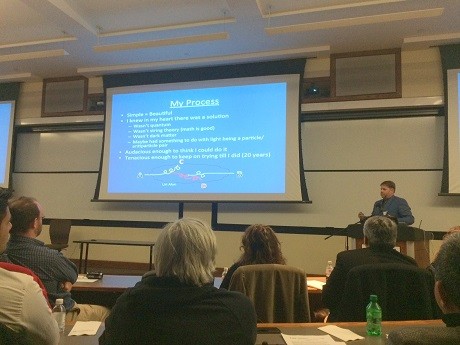
Annett presented a way to reconcile quantum mechanics with the theory of relativity as a step towards a Theory of Everything, the same kind of theory that Steven Hawkings is trying to develop. He said his solution, based on the idea that the universe is expanding as a spherical shell, if proven correct, could revolutionize the semiconductor industry, which is based on quantum mechanics.
“Everyone is trying to come up with a quantum theory of gravity. I did the reverse. I came up with a gravitational theory of quantum,” he explained, in response to a questioner.
“My real focus is to inspire the next generation of girls and boys to be audacious,” to reach for that big idea, and “to eliminate from their vocabulary that phrase, ‘You’re no Einstein,’” he added.
The panelists were clearly stumped by the advanced physics and math involved, but one asked Annett what he needed to go forward, and he answered that he wanted to share the creative process he used to come up with his discoveries with the world and shine a light on his proposed answers to these big questions.
A video of his presentation can be found here.
Synthetic Genomes on p-Chips Moonshot
Richard Morris, CEO of PharmaSeq (Monmouth Junction), talked about creating synthetic genomes by using p-Chips, ultra-small micro-transponder tags developed by his company, along with high-speed sorting and computing equipment.
“This could be to the genetic community what the PC was to the computer world,” he told the panel in response to a question.
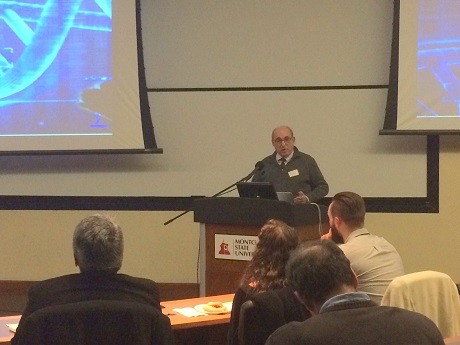
| Esther Surden
With this technology, according to Morris, the company could sequence a genome in a single day, greatly reducing the cost of creating an artificial genome. “The cost of doing this has actually been stuck for the last few years,” he said. Morris also mentioned that his company had come up with a design that will allow it to synthesize large libraries of DNA that could be used in anything from plants to industrial enzymes.
The application has great potential for designing custom vaccines, customized medicine and therapeutics. In response to a panelist’s question, Morris did admit that there could be some ethical concerns with synthesizing DNA in general.
View Richard Morris’s presentation here.
Smart City Newark Moonshot
Michael Ehrlich, associate professor at New Jersey Institute of Technology’s School of Management and codirector of the New Jersey Innovation Acceleration Center, and Seth Wainer, CIO of the City of Newark, jointly presented an idea for turning Newark into a Smart City prototype, based on the fact that the city sits on an “underutilized, world-class fiber optic network.”
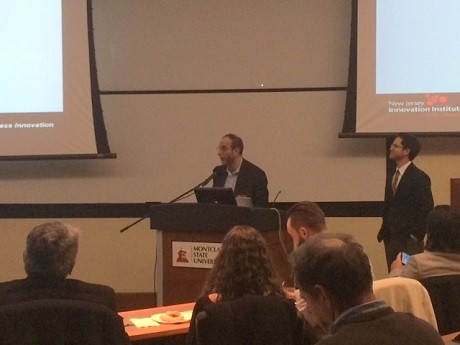
“We plan to establish a free, city-wide gigabit Wi-Fi network and an interoperable Internet network of things,” Ehrlich said. The system would be owned by the City of Newark, but managed as an open system. It would have a plug-and-play environment that would make it easy for developers to prototype and deploy new technologies to solve urban problems. Innovation, entrepreneurship and commercialization of new technologies would be accompanied by a broad array of training, incubation and business-acceleration opportunities, said Ehrlich. “Our urban centers have the potential to become the new frontier.” He added that we should think of connectivity as the new electricity.
Elaborating on Ehrlich’s theme, Wainer said that they envisioned Newark as a place where developers of devices for the Internet of Things could develop and test their ideas and products on a city-wide scale. It could also be a place that would enable a technological revolution for the urban dweller. Wainer said one example would be a company developing a low-cost device to track whether or not someone is entering a vacant property unauthorized.
Asked how they would pay for the additional infrastructure to make this happen, Wainer answered that it’s not an issue of finding the money, given that many high-tech companies in Newark are interested in making Newark into a test bed. But there are “issues of imagination and collaboration.”
The judges were skeptical that the cable companies and telcos would think kindly of free, city-wide Wi-Fi, as they’d likely believe it would undermine their own profitability. But Wainer answered that they wouldn’t be competing with these companies. The core would be a free data network enabling people who want to develop new services, like traffic-accident detection, to develop these services at a very low cost. From that perspective, said Wainer, “[what] we are looking to do is develop a test bed in Newark that can be deployed to other cities nationwide.”
A video of Ehrlich and Wainer’s presentation can be found here.
How Can We Help the World Feed Itself? Moonshot
Last to present was Lou Elwell, cofounder and CEO of Bio Soil Enhancers (Hattiesburg, Miss.), who pitched products that contain SumaGrow, which he called “concentrated mother nature.” Elwell explained that this product includes “naturally occurring microbes, nothing that is genetically modified.” Elwell’s “X” was “how to help the world feed itself.”
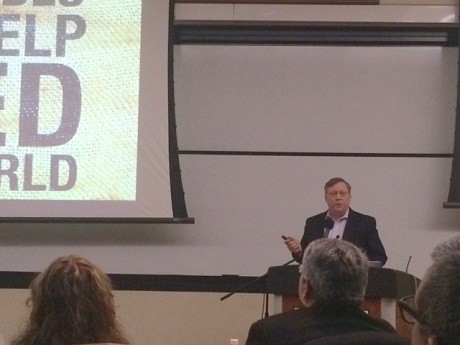
Farmland isn’t keeping up with population growth, he told the audience, and the amount of crops per acre is not increasing anymore. “In the best case, we are headed for higher [food] prices, in the worst case, food shortages.”
SumaGrow emphasizes “the biology of naturally occurring microbes in the soil, not the chemistry,” said Elwell. “Microbes provide higher yield, every field.” The product is certified organic and approved for organic farming. It is factory-made, rather than composted, he said. Moreover, it easily fits into existing farming methods and is less expensive than fertilizer.
Asked by the judges what the biggest challenge is to scaling this product, Elwell answered that the it’s the regulatory environment, since SumaGrow is not a fertilizer or a chemical. He said that the product’s export code is “miscellaneous agriculture,” a category that is often held up due to regulations or the lack of regulations in the countries they export to.

